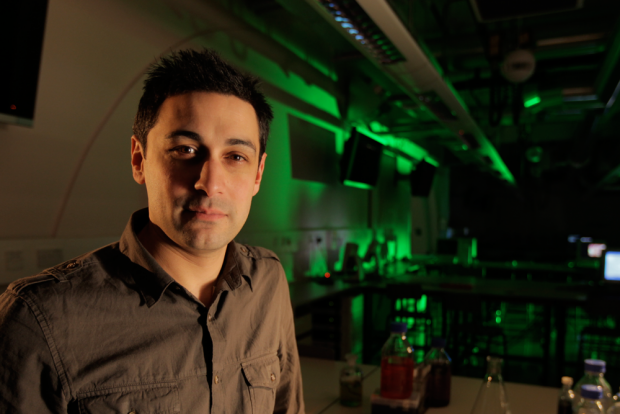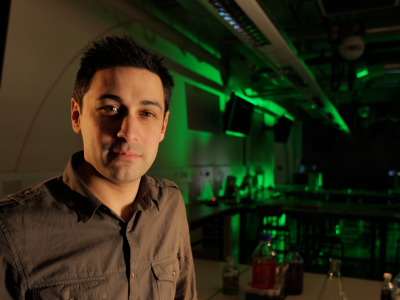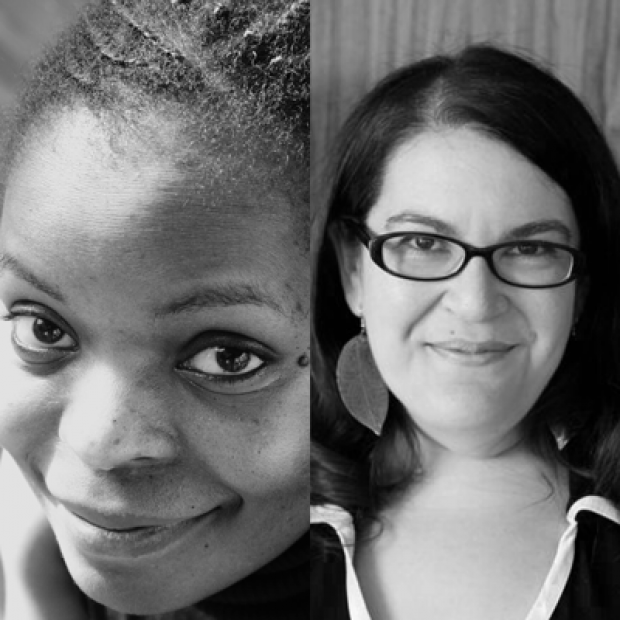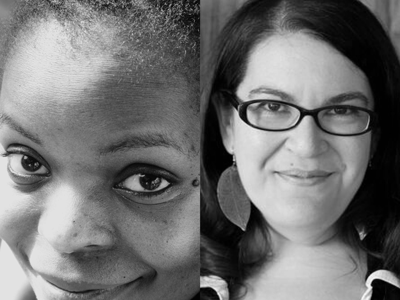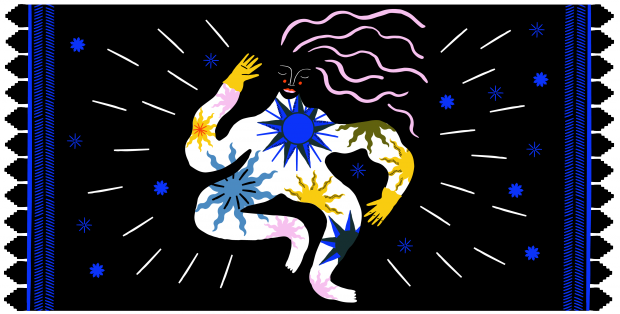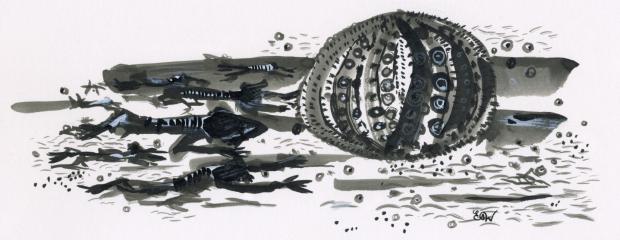The power in our genes

The third and final Little Atoms Two Cultures in Conversation event took place in London on 17 January 2017, when Little Atoms’ Neil Denny was joined by novelist Naomi Alderman and science writer Adam Rutherford. Neil began by asking Naomi about her latest book, The Power.
Naomi: The Power is about what happens when all of a sudden, almost all the women in the world, develop the power to electrocute people at will. Bzz. And everything changes. It doesn't take too long for a lot of things to be quite different.
The book follows four characters. There's Roxy, who’s the daughter of a crime family in London, and she had thought that her three older brothers would inherit, but she starts to get an idea that she might want it instead. There is Tunde, who is a male journalist – that’s what we call journalists if they are men, there’s journalists and male journalists. He decides he wants to write a book chronicling the great change in the world, and so he goes travelling and gets himself into trouble, y'know boys getting themselves into trouble, when they should just keep themselves nice at home...
There is Allie, who at the start of the book is living in a foster family and is being abused and she very rapidly deals with that and then goes on to found her own religion.
And there is Margo, who is a mayor of a town in New England, and she has an idea for how big business could get involved in helping these girls, and we all know how public-private military partnerships work in America.
When I wrote The Power I thought the idea that you might end up with a President of the United States who might really threaten nuclear war was a bit far fetched. But unfortunately events have proved me distressingly wrong about that, and now it's got a sort of apocalyptic tone to it, because I don't actually think that women are nicer to men and would just be lovely if we could electrocute people at will.
Listen to The Power In Our Genes on the Little Atoms podcast
Little Atoms: The book's also a bit zeitgeisty, in that some of the – I won’t say heroes, but some of people who perform quite important functions in the plot are men’s rights activists.
Naomi: Well, I have the benefit maybe of having been a woman working in the games industry for the past few years, so whilst the idea of men's rights activists and Milo might be brand new to many people, to women working in the games industry this bunch of loose stool water buckets have been plaguing us for a while.
When I wrote The Power the idea of a President of the United States who might threaten nuclear war was a bit far fetched
There was a campaign called Gamergate a couple of years ago, which was basically “wouldn't it be nice to harass some women who work in games, until they could no longer leave their houses?”
An amazing thing happened to a woman that I know who works in games. Some men's rights activists got annoyed with her, so they posted adverts on Craigslist around the country with her home address on it, saying “I have a rape fantasy, I want people to break into my house and rape me, and if I say no don't stop because that's my fantasy.”
For the novel, it was a benefit to have been exposed to some of that.
Little Atoms: Do you get the sense that your novel's a little bit unrealistic, now all this stuff exists in the world.
Naomi: I'm getting the sense the novel didn't go far enough, man. You can't really go wrong, you can't really overestimate the horribleness of some people. That is the problem, it only takes a few to make us all frightened.
Little Atoms: You mentioned earlier that it isn't “women are much nicer and fluffier and therefore the world would be a better place”. That's not how the book pans out. And things actually get worse and worse and worse until it ends with something of a big event. But everything that happens in the book is actually something that's really happening somewhere.
Naomi: Yes. Sometimes interviewers have said to me, “This is a dystopia”. And what I say about it is there is not a single thing that happens to a man in this book, that isn't happening to a woman right now, today, somewhere in the world. So they work out how to do a form of penis curbing which is burning out some nerves at the base of the penis, so that a man can only get an erection if a woman gives him an electric shock, and it will always hurt him to come. And if that is really, really horrifying to you, that is what female genital mutilation does, and that happens to women living in London right now. So yeah, if this book is set in a dystopia, then we live in a dystopia.
There is not a single thing that happens to a man in this book, that isn't happening to a woman right now, today
Blokes have been a bit horrified reading the book and look at me as if to say “how could you write these things?” And I'm like, “have you really never thought about what it might be like to live in a world where there's just casual constant threats of violence to women?” But I think the answer is no, it's a very different thing to see a gun pointed at somebody else's head and go, oh that's terrible, than it is when it's pointed at your forehead. It just feels different.
Little Atoms: Tell us about the electric shock thing. How does it actually work?
Naomi: I made a programme for Science Stories on Radio 4 about electric eels, and a lot of the stuff that I couldn't put in the programme ended up in the novel, because electric eels are amazing. They have an organ, the organ of electricity, basically it's a set of membranes and some muscle where they push certain electrons through a semi-permeable membrane, and then you release them explosively all in one go and that causes an electric shock.
Adam: You're looking at me for support and I’ve got no idea!
Naomi: It's like sodium ions? I think it's sodium ions. It's essentially the same thing as the axons in your brain.
Adam: Yes?!
Naomi: Anyone here know what goes through a semi-permeable membrane in the axons in your brain?
Adam: Well lots of things but it could be sodium ions.
Naomi: If you were to stand in a swimming pool and a fully charged adult electric eels were to discharge, a full discharge from an electric eel would kill up to five people. So I give women in this book an organ of electricity across the collarbone, which would make it probably longer and fatter than the ones electric eels have, and so different women have different amounts of electricity, which seemed reasonable, but the strongest people can kill a bunch of people. And it does all basically make sense, how that works. I did enough research that it makes sense.
Another thing electric eels can do is a form of electrolocation. So they send out electric waves, like small pulses into the water, and they can tell where things are. And they can do a sort of remote control of their prey fish. So if they're looking for a prey fish in – you wouldn’t call it undergrowth underwater, would you? But like rocks and plants and so on underwater. They can send out a controlled electric burst which makes their muscles twitch – the prey fish's muscles twitch so they can see where the prey is.
And they can do a thing that confuses them, so they think they are swimming away, but in fact they are swimming towards the mouth of the electric eel. It's super cool. We don't even know all the things they can do yet.
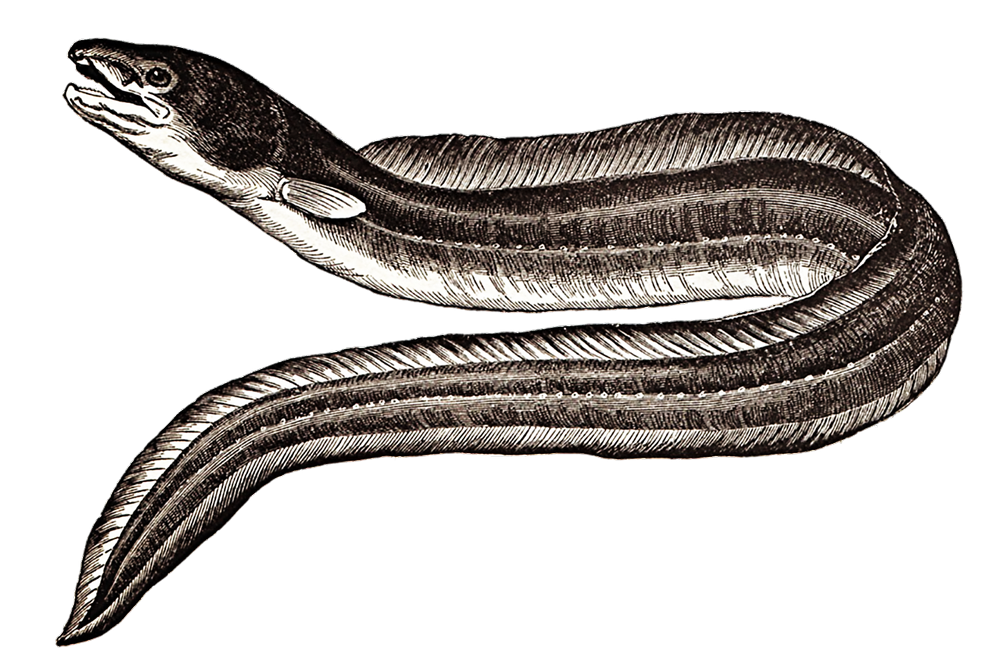
Little Atoms: So the organ has probably been present in these women all the time, but, it's only loosely speculated about in the book, perhaps some sort of pollution or something has caused this to develop.
Naomi: Yeah, so I used a slightly debunked theory called the aquatic ape theory, which is you've probably heard. It's a nice theory – there's not a lot of evidence for it – but it’s nice enough for a novel. Aquatic ape theory says the reason that human babies are born quite fat and able to swim and with, vernix, a sort of waxy substance, on their skin, and the reason we have much less hair than other great apes, is because at one point we went through an aquatic or a semi-aquatic phase in our evolution, in which we were either living on the seashore, which is probable, or living in the water, which is much less probable.
Adam: Much less.
Naomi: Much, much less.
Little Atoms: Adam's being very polite.
Naomi: You don't think there was a point where human beings had gills then?
Adam: There was, but they weren't human beings then, they were fish, and it was about 450 million years ago.
Naomi: I did the disclaimer that this was basically debunked, but it's a fun theory.
Adam: I've got no problem with it at all, I mean aquatic ape is not a good scientific idea, in fact it's not even a singular scientific idea, I can talk about aquatic ape all night if you want.
Little Atoms: No, we're not going to do that. What I do want you to talk about though perhaps for a moment is epigenetics.
Adam: [undertone] Oh for fuck’s sake
Naomi: Oh yes do talk about epigenetics.
Adam: Well go on then ask me a question.
Little Atoms: Is this power some form of epigenetics? Something that's dormant that gets reawakened by sort of external stimulus.
Adam: Well sort of yes. Well, who's familiar with what epigenetics means? Okay. So epigenetics is the phenomenon in biology which is literally the modification of DNA, because your DNA over one’s life does not change, the DNA that you're born with is the DNA that you'll die with, with minor modifications according to mutations if you get things like cancer.
It has become enormously fashionable in the last few years to talk about epigenetics as if it was something both revolutionary and new. And it’s neither of those things
But epigenetics is one of the mechanisms by which your DNA is expressed differentially, from conception to death, and it's one of a variety of mechanisms by which your genes are modified, so they're expressed at the right time and place. Because we start as a single cell, and after a few hours we're multiple cells that are mostly identical to each other, but by the time you're born you consist of trillions of cells which are, with hundreds of different cell types. Now, epigenetics is one of the mechanisms by which those cells get turned into the difference between a cell in the retina and some bone or a blood cell, or whatever.
The reason I roll my eyes when epigenetics comes up is because it has become enormously fashionable in the last few years to talk about epigenetics as if it was something both revolutionary and new. And it's neither of those things. It's a very interesting and not insignificant part of normal biology, but it isn't revolutionary and it isn’t new and it isn’t unique, it's one of many mechanisms by which what I’ve just described – how genes are turned on and off.
But you know, science massively prone to fashions. Not just in the popular press, how we talk about new discoveries, but also in terms of how grants are funded. What is popular attracts more grants. And I don't think epigenetics is not important, I just think it's not that interesting.
Little Atoms: Before we get to Adam's book, there's one more thing about The Power. And Naomi, I remember years ago when we talked about your book The Liar's Gospel. That was a historical novel about an imagined life of Jesus, and obviously that involved a hell of amount of research before you got anywhere near actually writing the book. So beyond researching the things like the electric eels, how do you go about researching a speculative novel?
The capacity for violence and the capacity to cause pain is what lies at the root of a lot of the gender differences
Naomi: Actually you can. I read a lot of stuff about organised crime, which is really interesting, because my thesis is that the capacity for violence and the capacity to cause pain is what lies at the root of a lot of the gender differences that we see in the world. So I thought hard about where in the world the capacity for violence translates most quickly into other forms of power.
Power is fungible, you can turn different kinds of power into other different kinds of power. You can turn money into political power, you can turn political power into religious power, you can turn religious power into control over media. You can use one to get another. And it seemed to me that starting out with crime is a good place where the capacity to hurt someone really a lot easily turns into cash. Which can then be turned into almost anything else.
Misha Glenny's book about organised crime in eastern Europe talks about how the oligarchs became rich. The Soviet Union collapsed not in an orderly way, but in bits, so there might still be a bit that was allowing a certain company to buy oil from the state regulators at fixed prices, but then the other bit that was selling it onto the open market was not state controlled anymore, so you could buy it at a very low price from the government and sell it at whatever was the market price, and that is how a bunch of people became extraordinarily wealthy.
In a certain way history can be quite useful, I remember in the Arab Spring, there was this sort of - there were people talking about it going 'Oh this is amazing, this is wonderful, look what's happened in Egypt, they've toppled their government, and the military have taken over, and there was a moment of excitement and I, having read a lot of history in my time, was looking at this going, “is this something which we're pleased about, when a military junta takes over? Does that usually work out OK? Maybe it's better than the previous thing, maybe not?” The more history you read, the more you know about the really terrible things people do to each other.
Watch the whole talk below
If you really want to read something much worse than anything I have written, go and get a book about what happened in the Belgian Congo. At that point, the idea that there will be things that will be unimaginable that people could do to each other – no, there's nothing.
And I guess my whole life has been research about writing about invented religions. I grew up a very Orthodox Jew, and I remain fascinated by weird religions.
Adam: As a former Orthodox Jew are you allowed to describe Orthodox Judaism as a weird religion.
Naomi: I've got an arrangement with God. I don't bother him, he doesn't bother me.
Adam: I'm not going to argue with that.
Little Atoms: Adam, A Brief History of Everyone Who Ever Lived: people will delighted to know that it's not 10 foot tall with a little paragraph about literally everybody who ever lived.
Adam: Well there is a small caveat in that, it's not an A to Z. I have had complaints from people, including on Amazon.
Little Atoms: “Where am I, I'm not mentioned?”
Adam: “I went through the index and I'm not in there.” It's not a phone book dude. No, the premise is it’s a history book. So it's great that we're talking about history books, because I as a geneticist spent a lot of the last few years reading history, which is new for me, well since GCSE history.
But the premise is that in the last few years, 10 years maximum, but really only the last five or six years, DNA has been added to the set of historical tools and sources that historians can use to reinterpret the past. Some areas have been utterly revolutionised, completely transformed by the addition of DNA to more traditional forms of understanding the past.
Other areas have verified what we already knew, others have challenged, and so that's the idea. It's a history book where DNA is the source.
Little Atoms: Everybody in this room, even if they didn't study science at a particularly high level, will be familiar with a guy called Rudolph Zalinger's diagram the March of Progress. What's up with this, Adam?
Adam: Everyone's familiar with this image, where you have small lemur type monkey type things on the left hand side and they gradually become bigger and more upright and eventually end up the ultimate form of homosapiens, which is a white bearded man carrying a spear.
Naomi: A mediocre white man.
Adam: Yeah. And also, they've all got their right legs in front of their left legs, so you can't see their genitals as well. Given that this whole idea is about the transmission of biological information from one generation to the next over evolutionary time, being prudish about your cock and balls is possibly not the most progressive way to think scientifically.
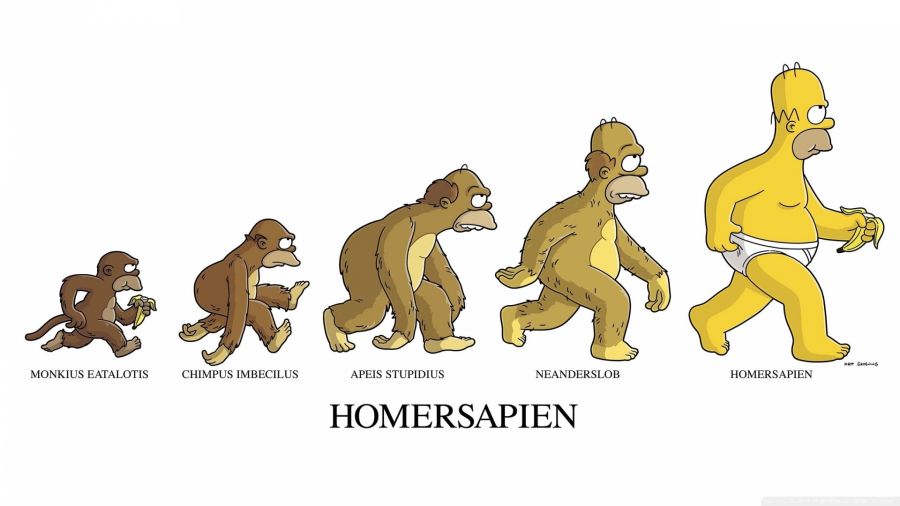
Anyway. I've got two issues with it.
One is that it implies that there is direction to our evolution and that the ultimate form of in our evolutionary trajectory is both homo sapiens and a white bearded man with a spear. Now apart from being politically peculiar, it's just scientifically illiterate. There is no direction to evolution in any form it takes. Humans are no more or less advanced than any organism that exists; we don’t talk about higher or lower organisms these days, because we've existed for a much shorter period of time in our current form than pretty much all other organisms on Earth.
And the organisms that have lasted the longest, and will outlast us, outnumber and outmass us, outweigh us, are bacteria. They are the dominant form of life on Earth. So the first problem is that there is no direction to evolution, we are simply the product of time and chance.
The second issue I have with it is a more scientific problem, which is as a result of looking at DNA and using DNA, particularly ancient DNA that has been retrieved from bones that have been in the ground or in caves for tens of thousands of years now, we really have no picture, no cohesive structure to human evolution.
And when we were growing up, we had these nice branching trees, which said there was homo erectus here, and there was Australopithecus and homo heidelbergensis, and this led to homo neanderthalensis and blah blah blah.
There's no picture now. We now know that with what we used to call separate species, like homo sapiens, homo neanderthalensis – and now we've discovered a couple of new species for which we have either no or very few bones – interbreeding occurs on many occasions between at least those four species.
Naomi: What are the other two?
Adam: One is a character called the denisovan. We have a single molar and the fingertip bone from a juvenile female. Now that is not enough to categorise a species which is done morphologically, historically.
Little Atoms: Literally, one tooth and a fingertip.
Adam: Yep, from a teenage girl. But it was enough to get the full genome out of, and this was 2010 or 11, and by getting the full genome you then compare it to homo sapiens, our own DNA, it's too different for it to be considered the same species. The same happens with homo neanderthalensis.
Naomi: But you can find DNA from that in humans?
Adam: But you can find DNA from the denisovans in humans, especially the further east you go. So the only samples we have for denisovans are in Siberia, in Denis’s Cave. He was a hermit who lived there for a few years in the 19th century, and now he's got a whole species named after him. It's funny how these things pan out.
Naomi: That's not what he wanted. He just wanted a quiet life.
Adam: Weirdly, that's precisely where neanderthals’ name comes from as well. Joachim Neander changed his name from Neumann, which means “new man”, to Neander, which means “new man”, but in Greek, and then he went and hid in a cave in the Neander valley outside Dusseldorf to contemplate be religious, and that was the site where the first neanderthal bones discovered.
Naomi: But it wasn't the hermits who found those bones.
Adam: No, both the hermit stories are completely irrelevant to the science.
Naomi: I've got a theory for you here. I suppose if you are a hermit looking for a lovely cave, you might pick a cave that humans or human-like species have previously looked at and gone, “Ohh, this is lovely”.
Little Atoms: He’s picked a good cave.
Adam: He has. I don't know anything about the Dusseldorf cave because it was destroyed in the 19th century by miners, and re-excavated when they found bones subsequently, but it doesn't exist anymore, but Denis's caves – why are we talking about caves again?!
Naomi: I'm asking you about caves
Adam: The Denis cave still exists and has been occupied by thousands of species for thousands of years. It’s a nice cave. It's got a river-front view. I'm not just plugging the book here but I describe it using the language of estate agents. It has a spacious central cavern with several side rooms and a working chimney. I mean it's absolutely ideal for your 19th century hermit.
Naomi: It's absolutely ideal for you to go in there, lose the tip of your finger and a molar.
Read Katy Evans-Bush's poem Do the Culture Clash
Naomi: OK, so there's Neanderthals, Denisovans and what's the other one?
Adam: This is the one where it gets really bizarrely, almost surreally exciting for the average geneticist. Because we have literally no bones for this organism. So if you compare the DNA from a Neanderthal, homo sapiens and the Denisovans, we can see interbreeding between Denisovans and Neanderthals, homosapiens and Neanderthals, homosapiens and Denisovans, basically a three-way. Not at the same time.
Naomi: Do you know that?
Adam: No we don't. What a time to be alive! We weren't fussy back in the day. But you see different distributions of those different types of DNA across the world. The Neanderthals were primarily European with a slight bit of Eurasian, so the more white and European you are the more Neanderthal DNA you'll have in you, and the further east Asian you are the more denisovan DNA you'll have in you. There was very little what was referred to as back flow, of both Denisovan and Neanderthal DNA back into Africa, although there is some.
So you compare those four and the differences between them don't add up, so there's a missing contribution that injected DNA, you know, euphemistically. Well they're called “gene-flow events”, which I think is one of those brilliant euphemisms. So there were clearly gene flow events between something with which we have no DNA – we have no physical remains. It may be one of the fossils we know exists but haven't got DNA from, but there is a phantom species that we carry in our DNA that we don't know what it was.
Naomi: What do we call it?
Adam: It doesn't have a name...
Naomi: Ah... you could name it.
Adam: Phantom species?
Adam: Homo phantomas.
Naomi: So eventually are we going to be able to recreate that species?
Adam: Well, it's a very...
Little Atoms: Like Jurassic Park?
Adam: Well people have suggested this seriously. Resurrection of species is a little bit like epigenetics. It's something that people talk about a lot because it's so attractive as a sort of sci fi idea. It's – I think it's so far from being possible that...
Little Atoms: I think bollocks is the term you're looking for.
Naomi: It's not bollocks though, is it, it's just very very difficult and we haven't got the tech for it.
Adam: OK, there's a couple of issues right. So I think it's likely that in the next few years we will recreate, we will bring back maybe a species that died in the 20th century.
Naomi: Like the quagga.
Adam: Right, because they're recently dead and we have good DNA for them, and we understand where they fit in evolutionary species terms, we've probably got good models for doing what needs to be done, which is taking a cell from an existing species, synthesising the DNA from the extinct species, getting the DNA into the cell of the existing species, then getting that into a pregnant female and letting that develop to term. People have seriously talked about doing this with mammoths.
Naomi: Wow.
Adam: Because we have a really decent quality mammoth genome. What do get as a result? Apart from the fact that you've got a female elephant giving birth to a different species. It's not really cool. We don't even know how big a mammoth would be at birth.
Naomi: Oh. That sounds like a poor lady elephant there, having a nasty time.
Adam: And you'd be really confused, and also when the creature is born, it's a bit lost. What is my identity as a creature?
Little Atoms: Yeah, and it's got nothing else it can mate with, you've only got one, life is pointless.
Naomi: That's an argument for making a hundred, not an argument for not doing it.
Adam: But we don't know its environment, we don't know what it fed on, and it becomes a boutique species, it becomes something that can only exist in zoos.
However, having had this conversation weirdly on Irish radio a couple of years ago, when the mammoth genome was published. I come from a Catholic family, and I was on in a discussion with a priest, and there was a point where during the discussion I found myself describing the vaginal tract of an elephant, and being quite confused that that was happening live on radio, and also being quite confused that I knew so much about the vaginal tract of an elephant, because it turns out that your average female elephant has about a seven foot vagina, which has a right angle, and that male elephant has a prehensile penis so it can negotiate the...
Naomi: Wow! But then how does the baby elephant get out?
Adam: OK well, then they've got like a hymen – this isn't what we came here to talk about is it?
Naomi: We came to talk about genetics, we obviously knew we'd be talking about sex. Continue.
Adam: Then there's this enormous membranous sheet, which has a tiny pinprick hole in it, which is also part of the difficulty. You know, vaginas are designed to make getting pregnant as hard as possible, so you've got to have a prehensile penis which is seven foot long with a bend in it, and then you've got to be able to negotiate it through this two millimetre wide hole. So we know this because artificial insemination has been done in elephants, and so understanding the elephant vaginal tract is important.
Naomi: You were going to say how a baby elephant gets out and then move onto mammoths.
Adam: Oh, can't we just talk about something else?
Naomi: How does the lady elephant give birth?
Adam: Well through the, by the natural way.
Naomi: Are there some muscles that help it round the corner?
Adam: D'you know what, having had this conversation on national radio, national Irish radio with a priest, I've realised I'm well past the limit of my understanding of this subject.
Little Atoms: OK let's move on...
Adam: None of that is in my book!
Naomi: But I'm clearly researching a new novel.
Little Atoms: Let's move the conversation on from massive elephant vaginas to TV's own Danny Dyer.
Naomi: Has he got a prehensile penis?
Little Atoms: Seven foot long apparently! People in the audience, may be familiar with the aforementioned Danny Dyer's appearance on the programme Who Do You Think You Are? where it turns out, amazingly, Danny Dyer is related both to Thomas Cromwell and Edward III, former king of England. Danny Dyer, that's amazing right?
Adam: It was a brilliant programme, it was some of the best TV I've seen in a while. During the course of this hour long programme they take a B-list celebrity and do traditional genealogy and ancestry and trace a line in their ancestry and find out that inevitably they were descended from either a duke or a duchess, or a scullery maid. There seem to be a lot of scullery maids in people's ancestry...
Naomi: Those sculleries didn't clean themselves.
Adam: They didn't. But, Danny Dyer, who I understand is the current landlord of the Queen Vic in Eastenders, and he did some quite good films when he was young, and then he did a lot of bad films after that. Anyway it's got this brilliant scene at the end when the genealogists reveal on this scroll, this rolled out family tree, that he's 21 generations directly from Edward III, the first Plantagenet king.
Little Atoms: That's amazing, what are the chances?
Adam: Well, it turns out the chances are 100 per cent. Because of the way that family trees actually work. We think about our family trees in very linear ways, and when we trace our ancestry, we tend to only focus on the interesting people and the people for whom there is a paper trail, the people you can get family records for. Now of course in the past, the further you go back in the past, the less likely you are to be someone who has left a physical mark on the Earth, unless you're a royal.
And so the royal family trees are the ones we have in immense detail, going back for not just to the 13th century, but for thousands of years.
Now there is a conundrum in family trees, which is everyone has two parents and four grandparents and eight great grandparents and so on, so every generation...
Naomi: Unless there was a cousin marriage involved.
Adam: That is true but I do account for this in the maths when I do the maths.
Naomi: Alright, continue.
Adam: So, you still have the same number of ancestors, it's just that they get crammed into fewer people, and that's really the point. There are more people alive today than there have ever been alive at any single point in history. Depending on when you start counting there's been about a 107 billion people on Earth and there are currently obviously about 7 billion.
The last common ancestor of all Europeans dates from about 500 years ago, probably somewhere in Germany
So if you take one individual, the further back you go in time up their family tree, the more ancestors they have to have. But the conundrum is that at any time in the past there have been fewer people alive than there are today. Both of those statements are true. So what you have to do is you have to cram all of your ancestors into fewer people, which means that after a few generations, individuals start occupying multiple places in your family tree. And this is effectively what we call inbreeding. But after a while, you get what is known as pedigree collapse, which is the point at which all your branches of your family tree begin to coalesce and fewer and fewer individuals.
The last common ancestor of all Europeans dates from about 500 years ago, probably somewhere in Germany. There is literally an individual. We don't know who this person was, but the maths declares that there is literally individual through whom all white people's family trees flow at least once. So that's the last common ancestor.
Naomi: I got my DNA analysed by that 23andMe.
Naomi: Oh, sorry, yeah. And I come from an Orthodox Jewish family, as mentioned, and I was like hoping for something super exciting, like oh look here, you've got ancestors from somewhere unexpected, and what I came out with, it's 98 per cent Ashkenazi Jew, 1 per cent Sephardi Jew, and very excitingly 1 per cent East Asian. So I've got something there, so there was some Mongol horde or something, or somebody was a trader with the Kazakhs or something. So this cannot be for me, can it?
Adam: There's no such thing as Jewish DNA.
Naomi: What?
Adam: Because as soon as you get to a point where you have a most recent common ancestor as an individual, the next interesting genetic point after that – before that chronologically – is called the isopoint. And the isopoint is where all lines of all family trees cross through all individuals. Yeah, but basically you can describe it in the reverse way which is there is a time in history where all the people alive are either the ancestors of either everyone alive today or no-one alive today.
It’s not so surprising that Danny Dyer is related to Edward III, because basically we all are
So, that number comes out for Europeans as the 10th century, so if you were alive in the 10th century, and you have descendants who are alive today, then you were the ancestor of literally everyone who is alive today.
Little Atoms: But this is going back to why it’s not so surprising that Danny Dyer is related to Edward III, because basically we all are.
Adam: So let me finish off the Danny Dyer story quickly, then we'll talk about the more interesting stuff. So he discovers he was 23 generations or whatever it was directly from Edward III, which is factually true and he can demonstrate this because they've got the family trees to prove it.
I did the calculation and I checked it with a colleague of mine at UCL. Because it's a royal family tree you can actually count the number of descendants that Edward III has for about three or four generations. And he was unusually fecund, so he had a lot of descendants, and by the time you get to great grand children, he's up to about 245, which is not totally weird, but it's decent enough. Then you begin to lose track of people because there are just too many.
But if you take a simple calculation which is, that on average people who reproduced at that time would have two children, then by the time you get to 1600, then the number of direct descendants of Edward III is around about 20,000. Again, it's a big number but it's totally plausible.
Then you work backwards from 1975, which is the year that Danny Dyer was born, I think, and assuming a generational time of about 25 or 27 years, you count up the number of ancestors that one should have going that far back in time and it comes out as I think 16,000, and then the population of Britain at this time was about 4.8 million, and then you sort of divide these numbers into each other. I mean it's not much more complicated than that.
And the number you come up with is that everyone who was born in 1975 should have a maximum number of 118 ancestors who are directly descended from Edward III. And even if you're out by a factor of two orders of magnitude, you should still have eight.
So basically the chances of any ethnically white British person not being descended from Edward III are... I can't remember the exact number but p is less significant than 98th percentile. The chances are that almost all of you are descended from Edward III. And all of you are descended from Charlemagne, because you go back another 400 years and the genetic isopoint has occurred. The exceptions...
Naomi: But we wouldn't all be descended from Charlemagne if for example we were indigenous Australian people.
Adam: No, that's true, this is specifically from Europe and the further you go from Europe the more distant it is. However, however, the genetic isopoint for everyone on Earth is about three-and-a-half thousand years ago.
Naomi: So long after the end of the last ice age.
Adam: Ramesses II we're talking here.
Naomi: That is not that long ago.
Adam: No, it's well into the old testament, it's well into – it's half way through history.
Naomi: People had agriculture, they were making alcohol by that point.
Adam: Oh, there were pyramids, we had pretty sophisticated culture.
Naomi: We had money, writing
Adam: And there's no-one alive on Earth today who is not descended from exactly the same people about 1400 BC. So you're right to point out that Charlemagne only works for most of Europe. Sometimes people of East Asian descent say my ancestor was Genghis Khan. It's true because everyone east of the steppes is descended from Genghis Khan
Naomi: If I've got 1 per cent East Asian, I've got some Genghis Khan, which I can feel in myself.
Adam: Yeah, yeah. But the point about my Jewishness is that.
Naomi: My fake Jewishness.
Adam: It's not fake, it's just that what we're talking about here is the proportion of DNA which is common in different self identifying ethnic groups.
Now Ashkanasism emerges as a medieval phenomenon within Judaism, and it accounts for about two third of Jews the world over.
There is no group of people on Earth who have managed to keep it within their own group for any length of time, for any significant length of time. The highest is probably the Saracens. So the Saracens who live on a mountain. But they had to start outbreeding because they were so inbred they couldn't reproduce. So not even them.
There are no islands in the South Pacific where there hasn't been gene flow from external parties.
India's quite interesting, because Indians have been practicing caste for about two or three thousand years now, and that is a class structure which does – endogamy is the term for it, where you are breeding only within a social structure, and we do see certain genetic traits emerging within castes and not within other castes. But still chapter one of the book is called “Horny and mobile” because that’s what people are.
So my step mum was, her father was an orphan raised by the Sisters of Mercy in Liverpool. And we didn't know much about his father, apart from his name. And Liverpool being a port town, he was called John Adams. And then when we started looking a couple of years ago, he wasn't called John Adams, he was called Joseph Abrahamson, and he was an Orthodox Russian Jew. The casualness with which people can abandon decades or hundreds of years of ancestry. Just gone, like that.
And in fact there are thousands of examples of Jewish people in this country who have names like Kay and Gee and Cohen, who are called those things in the first two examples because immigration officials couldn't spell Kaplinsky or something beginning with G, and Cohen because oh you're Jewish, you're probably called Cohen.
I actually had a brilliant moment of – it's not mansplaining if you're talking to another man, is it, it's just patronising. A friend of mine called Cohen, Andrew Cohen, and I said, so you're a Cohen and he said well no. And I said, if you're a Cohen then you're directly descended from the Cohanim, the paternal branch of high Jewish priests, and he said no, and I said yes. And he said, no, we were given the name Cohen in the 19th century because my Czechoslovakian ancestors had a complicated name that no-one knew.
Naomi: So when I did the 23andme, and they obviously not having read my novels were nonetheless able to detect through my spit sample that I am an Ashkenazi Jew, they were doing that because my sample is very similar to a lot of other people who also call themselves Ashkenazi Jews.
Adam: That's right. There is no scientific method for determining where people’s ancestors come from using DNA. That doesn't exist. And these tests, which we've all had done and I expect some of you have had them done as well, are interesting, I think they're quite trivial, I don't think they really tell you anything.
Naomi: They're a sort of posh expensive version of a horoscope.
Adam: Um, I'm not going to say specifically about specific companies, but I describe them as genetic astrology. And some are better than others. 23 and me is a credible company, I think Ancestry.com is a credible company, others less so, but like I said, there isn't a scientific method for bless you for telling you where your DNA comes from in the past. What they tell you is where people on Earth today have similar DNA to you. So to be reductio ad absurdum, if, so, 2 per cent of my DNA according to my map comes from Sweden. Now having a parent who is northern European that's hardly surprising. It could be that everyone in Sweden moved there on January the 16th 1975 and that is where, the day I was born, and that is where that DNA comes from.
It could be that they've been there and they haven’t moved for the last 10,000 years – it's not. Everyone wants to discover that they're actually Viking. You are. You have Viking ancestors. That'll be £160 please. You have Jewish ancestors. You have Jewish, Viking and Saracen and French and Norwegian and African and probably Chinese ancestors.
Naomi: That's very exciting.
Adam: Yeah. It is. It's super cool. It's also kind of like trivial.
Naomi: Obviously I know that there's no such thing really as Jewish genes and the sense that when you go to India there are Indian Jews who, you know, appear Indian.
Gosh, it's very easy to stray into saying something that sounds a bit racist.
Adam: Welcome to my world. [laughs]
Naomi: I can only apologise if that just sounded a bit racist. I don't know where to go from that, someone else make a joke.
Adam: It is quite difficult to make, to write on this topic. Chapter four is called Race.
Naomi: What you're saying is actually that race is a social construct and not a genetic thing?
Adam: Well careful, yes. Yes it is.
Little Atoms: It also doesn't help Adam that your entire industry was basically founded by a massive racist for the purposes of racism.
Adam: That is precisely right. That is my direct intellectual genesis.
Naomi: But surely you're descended from all the different kinds of intellectual heritage across the world.
Adam: Well actually family trees in academia are much more linear, much more easy to understand. But I was an undergraduate in the Galton Laboratory where I still have an honorary fellowship. And Galton was Darwin's cousin and he was the founder of...
Naomi: Racism?
Adam: No. Racism has been around for ages. He was the founder of genetics. He was a brilliant statistician, a brilliant scientist in many, many ways. He was also quite an unpleasant person in many regards. His scientific legacy is unquestionably important. So let me just deal with the question.
I argue in the book that as a scientific term, the way we colloquially talk about race has no value.
As a scientific term, the way we colloquially talk about race has no value
There is no way of breaking up people genetically using DNA that corresponds to the way we talk about people when we use terms like race. And there are many examples – well there are all the examples. I go through a few in the book, and there are obvious ones, such as Jewishness is one. So in 1882 and 84 two doctors one in London, one in New York, Tay and Sachs separately identified a condition in young Jewish boys which became known as Tay-Sachs disease.
Naomi: Which if you are a Jewish person you get tested for when you are a teenager.
Adam: It's a neurological disorder which involves muscle wasting as well. It's a single mutation in a gene called Hex A and it's awful. It was identified in these two Jewish families, you see the emergence of recessive genetic disorders in families that have high degrees of consanguinity, inbreeding in them anyway. But within a few – and it became known as the Jewish disease. Now at this time in history, we're in a period where the anti-Semitism is going to crescendo towards 1945 right.
Naomi: But maybe again in the future.
Adam: Well, looking that way.
Adam: Anyway, so a couple of years later the same disease is identified in a non-Jewish family and it gets labelled something different. because it can't be the same disorder because these guys aren't Jewish.
Naomi: That's brilliant.
Adam: So, by, through the course of the 20th century we identify Tay-Sachs, and it's similar proportions in all sorts of populations around the world, Cajans, Canadians, French, at the same sort of levels as it occurs in Jewish families So it's quite clear that whatever it is it isn't exclusive to Jews at all. And ironically because there are more Jewish geneticists than other cultural... I'm doing it again.
Naomi: Jewish culture is very interested in education, that is a cultural trait of Jewish culture, and therefore we end up with a lot of people who are highly educated and many of them go into science and some of those become geneticists.
Adam: Thank you.
Naomi: My pleasure.
Adam: That was very handy, thank you for getting me out of that hole. As a result of that, as exactly as you've just described, Tay-Sachs now doesn't exist in Jewish populations because of a proactive recognition that it was a disease of inbreeding and consanguinity, and so through what we might refer to as soft eugenics, it has effectively been bred out of the population that it was originally discovered in. It's a great example of how we begin to understand how inheritance patterns actually work. Actually, the earliest description of inheritance patterns that are effectively genetics is in the Talmud, and it's a description in one particular tract where it describes how if your son bleeds to death on circumcision and if the mother has a sister whose first two sons also did, then the second and third sons from the first woman are exempt from circumcision, so there's a very small proportion of Jewish boys who are not circumcised, and what they're describing there is haemophilia.
Naomi: Brilliant.
Little Atoms: Wow. I did also promise some discussion of sci fi. Adam, I think this is in the book, it might just be something you've told me or it might be in the earlier book or something, but at some point you've been on some radio chat show and the interviewer has said, so Adam, when will human beings be able to fly?
Adam: Well, on aeroplanes today. So the story was, and this is true, it was, I do TV work and I was asked to go for lunch with a TV producer because they wanted to make what's known as a support programme for a major TV series, it was Heroes. Do you remember Heroes? The first season was quite good then it went a bit wrong.
Naomi: Fell off a cliff that show.
Little Atoms: I thought the first season was excellent actually.
Naomi: The first season was excellent and the second season fell off a cliff, we could do a whole like evening on why that happened.
Adam: And they've just relaunched it, but I don't think anyone watched it. It was basically the X Men.
Naomi: But it wasn't about anything, whereas X Men is really about something.
Adam: Yeah, civil rights.
Little Atoms: It's about racism, X-Men?
Adam: And homophobia.
Adam: The point was they wanted to do a programme on BBC 3 or 4 about the real science behind Heroes, y’know superpowers – genetic superpowers – do they really exist? So the opening gambit for this meal was, so, tell me, when are humans going to be able to evolve to be able to fly?
And I thought oh god, here we go. I'm going to give it my best smiley face because it’s work, y’know. And went into this impassioned description of how evolution works, but also the real significance to human evolution is that we are a technological species and the energy constraints and the reasons for evolving wings are not something which are conceivable within our current understanding of evolution, but what we did as our brains got bigger and the so called cognitive revolution 50,000 years ago, is we embraced technology in a way, I went on and on like this, it's all in the book, and I don't need to bore you with this kind of stuff, but it was sort of impassioned, and I was watching these two guys and there was a point where they were nodding at each other, and I read them as thinking yeah this is the guy. And I'm into comics, and I was making references to comics, I was talking about how there are blind people who can echolocate...
Naomi: Yes there are.
Adam: But not like Daredevil. Not quite as good as Matt Murdoch can do it, but nevertheless, I was saying the actual answer is we can fly, we invented this stuff, we used our evolved brains to invent the technology so we could do all of these amazing things because humans are amazing.
And they went yes, brilliant. So you think it'll be about 200 years? And I was like yeah, thanks a lot. Thanks for the pizza.

